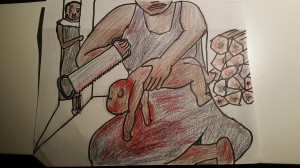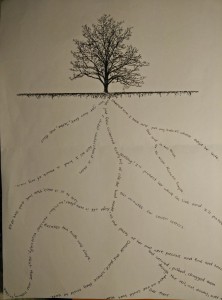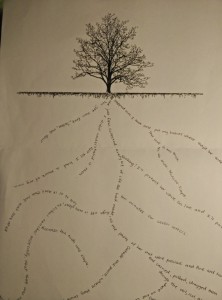In a novel “Beloved” by Toni Morrison, Sethe is a black slavery woman who suffers from the memory of her killing her own daughter. The daughter comes back to Sethe as Beloved, embodied spirit of the murdered daughter with venom and anger toward her mother. The moment of Sethe killing her daughter has tragic ramifications throughout the entire novel. Because of the infanticide, Sethe lost her two sons, Baby Suggs, the people in the town and the daughter Beloved. Without the occurrence of infanticide, the story would be totally different from the original novel.
When Sethe escaped from Sweet Home with her children, the four horsemen – schoolteacher, nephew, one slave catcher and a sheriff – came to the house on Bluestone Road where the runaway slaves were, including Sethe and her children. At first, the four horsemen thought they were too late to catch Sethe but they started to walk toward a shed when some other slave stared at the shed. “Inside, two boys bled in the sawdust and dirt at the feet of a nigger woman holding a blood-soaked child to her chest with one hand and an infant by the heels in the other. She did not look at them; she simply swung the baby toward the wall planks, missed and tried to connect a second time … “(Morrison 175). After Mr. Garner’s death, Sethe knew that unlike Mr. Garner, schoolteacher was same as other majority of whites, who can make the slaves to work, kill them, or dirty them. As she thought that she does not want their children to go through what she had been went through, she decided rather to kill their children by herself than to let it happen to the children. So she took all her children to the woodshed and killed her “Crawling Already?” girl, Beloved.
The fact that Beloved was killed by her mother led the entire story tragic that Sethe lost her sons and other people in the town. First, the baby girl who was killed by Sethe came back to Sethe’s house as a ghost. “124 was spiteful. Full of a baby’s venom.” (3) 124 is the house where Sethe and her alive daughter, Denver were living. Sethe’s sons, Howard and Buglar, left the house earlier “as soon as merely looking in a mirror shattered it (that was the signal for Buglar); as soon as two tiny hand prints appeared in the cake (that was the signal for Howard)” (3). Beloved was a baby when she was killed by her mother, so she returned to her mother as a ghost in the haunted house. If Sethe did not kill Beloved, the house would not be haunted with the baby’s venom. Because she killed her own daughter, people around her left her. For example, Howard and Buglar left the house not only because of the haunted house and the baby’s venom, but also because of the fact that their mother killed her own daughter and tried to kill them too. Also other black people in the town started to ignore the residents of 124.
Sethe killed her own child because she loved her and wanted to protect her from living as a black slave at Sweet Home – or anywhere in the world. In page 194, after Paul D found out that Sethe killed her child as she was escaping from Sweet Home, he said Sethe’s love is too thick. But Sethe replied to him that “Love is or it ain’t. Think love ain’t love at all … It ain’t my job to know what’s worse. It’s my job to know what is and to keep them away from what I know is terrible. I did that.” She told Paul D that she had to kill the children to keep them away from being slave, but Paul D said that decision was wrong. He added that “’You got two feet, Sethe, not four …’” Even Paul D who loved Sethe deeply in his heart, could not accept the fact that Sethe killed her own baby, and made him leave her.
Because Sethe killed Beloved her only alive daughter, Baby Suggs and Denver had to go through hardships as well. When Stamp Paid kept trying to get to 124 to talk to Sethe, he realized that he understood Baby suggs’ feeling too late. “The heart that pumped out love, the mouth that spoke the Word, didn’t prove or condemn Sethe’s rough choice. One or the other might have saved her, but beaten up by the claims of both, she went to bed” (212). Baby Suggs used to say the Word at the Clearing every Saturdays, but she refused to preach after Sethe’s act of infanticide. Also when Denver used to go to Lady Jones to learn to spell and count, she had to stop going to Lady Jones because of her mother’s past. Nelson Lord was a smart classmate, “who put a stop to it; who asked her the question about her mother that put chalk, the little I and all the rest that those afternoons held, out of reach forever.” Nelson Lord asked Denver the question about her mother’s infanticide out of curiosity, and she could not just laugh about it because Denver was actually wondering what happened for what reason. After that, she stopped going to the class and she became deaf because she did not want to hear the answer from her mother. Baby Suggs and Denver are important families to Sethe but she made them have hard time because of her past.
Lastly, Sethe’s act of infanticide made the murdered daughter to bear a grudge against her mother and return to Sethe as Beloved, the embodied spirit of murdered child. After Sethe found out that Beloved was the embodied spirit of her own daughter, she tried hard to explain how much she had suffered for her children for her whole life, but Beloved never listened. “None of which made the impression it was supposed to. Beloved accused her of leaving her behind. Of not being nice to her, not smiling at her. She said they were the same, had the same face, how could she have left her? And Sethe cried, saying she never did, or meant to – that she had to get them out, away … that her plan was always that they would all be together on the other side, forever. Beloved wasn’t interested. She said when she cried there was no one. That dead men lay on top of her. That she had nothing to eat” (284). Even though Sethe tried to explain and make Beloved understand what she went through and what she meant, Beloved was too young to understand her mother and the murder. She already had inveteracy deep inside.
There are moments or occurrences that have ramifications throughout the story in novels like Beloved. In Beloved, the moment when Sethe killed her own daughter made the tragic of the entire story and if this did not happen the story would be totally different than the original story. Because the daughter was murdered by Sethe, people in the town ignored Sethe and her family for a long time, and Sethe lost her sons and grandmother Baby Suggs, and the most important person, Beloved.
Morrison, Toni. Beloved: A Novel. New York: Knopf, 1987. Print.







